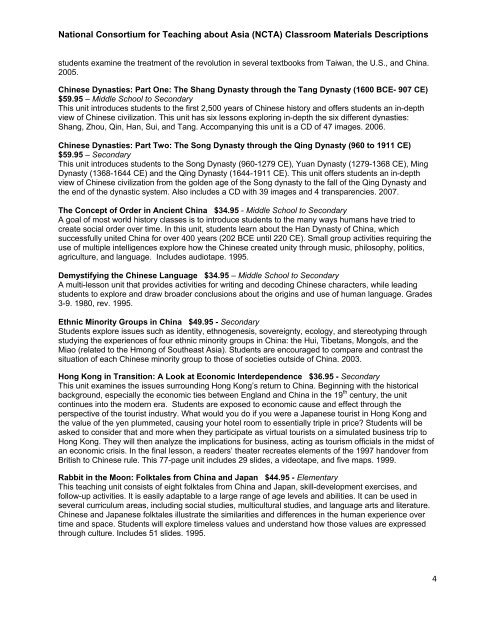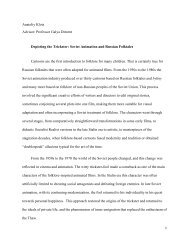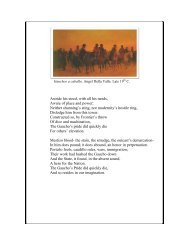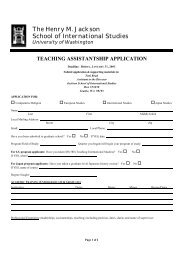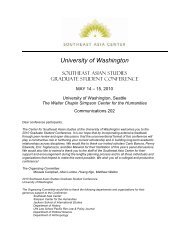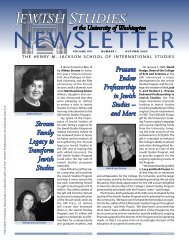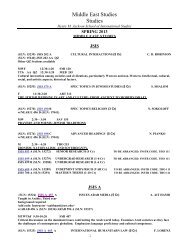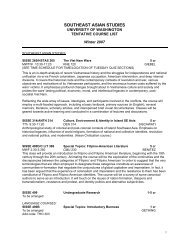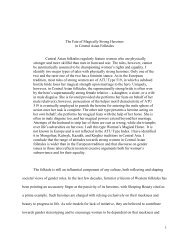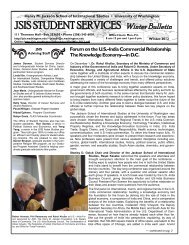Cobblestone Publishing Kamishibai for Kids - Jackson School of ...
Cobblestone Publishing Kamishibai for Kids - Jackson School of ...
Cobblestone Publishing Kamishibai for Kids - Jackson School of ...
Create successful ePaper yourself
Turn your PDF publications into a flip-book with our unique Google optimized e-Paper software.
National Consortium <strong>for</strong> Teaching about Asia (NCTA) Classroom Materials Descriptions<br />
students examine the treatment <strong>of</strong> the revolution in several textbooks from Taiwan, the U.S., and China.<br />
2005.<br />
Chinese Dynasties: Part One: The Shang Dynasty through the Tang Dynasty (1600 BCE- 907 CE)<br />
$59.95 – Middle <strong>School</strong> to Secondary<br />
This unit introduces students to the first 2,500 years <strong>of</strong> Chinese history and <strong>of</strong>fers students an in-depth<br />
view <strong>of</strong> Chinese civilization. This unit has six lessons exploring in-depth the six different dynasties:<br />
Shang, Zhou, Qin, Han, Sui, and Tang. Accompanying this unit is a CD <strong>of</strong> 47 images. 2006.<br />
Chinese Dynasties: Part Two: The Song Dynasty through the Qing Dynasty (960 to 1911 CE)<br />
$59.95 – Secondary<br />
This unit introduces students to the Song Dynasty (960-1279 CE), Yuan Dynasty (1279-1368 CE), Ming<br />
Dynasty (1368-1644 CE) and the Qing Dynasty (1644-1911 CE). This unit <strong>of</strong>fers students an in-depth<br />
view <strong>of</strong> Chinese civilization from the golden age <strong>of</strong> the Song dynasty to the fall <strong>of</strong> the Qing Dynasty and<br />
the end <strong>of</strong> the dynastic system. Also includes a CD with 39 images and 4 transparencies. 2007.<br />
The Concept <strong>of</strong> Order in Ancient China $34.95 - Middle <strong>School</strong> to Secondary<br />
A goal <strong>of</strong> most world history classes is to introduce students to the many ways humans have tried to<br />
create social order over time. In this unit, students learn about the Han Dynasty <strong>of</strong> China, which<br />
successfully united China <strong>for</strong> over 400 years (202 BCE until 220 CE). Small group activities requiring the<br />
use <strong>of</strong> multiple intelligences explore how the Chinese created unity through music, philosophy, politics,<br />
agriculture, and language. Includes audiotape. 1995.<br />
Demystifying the Chinese Language $34.95 – Middle <strong>School</strong> to Secondary<br />
A multi-lesson unit that provides activities <strong>for</strong> writing and decoding Chinese characters, while leading<br />
students to explore and draw broader conclusions about the origins and use <strong>of</strong> human language. Grades<br />
3-9. 1980, rev. 1995.<br />
Ethnic Minority Groups in China $49.95 - Secondary<br />
Students explore issues such as identity, ethnogenesis, sovereignty, ecology, and stereotyping through<br />
studying the experiences <strong>of</strong> four ethnic minority groups in China: the Hui, Tibetans, Mongols, and the<br />
Miao (related to the Hmong <strong>of</strong> Southeast Asia). Students are encouraged to compare and contrast the<br />
situation <strong>of</strong> each Chinese minority group to those <strong>of</strong> societies outside <strong>of</strong> China. 2003.<br />
Hong Kong in Transition: A Look at Economic Interdependence $36.95 - Secondary<br />
This unit examines the issues surrounding Hong Kong’s return to China. Beginning with the historical<br />
background, especially the economic ties between England and China in the 19 th century, the unit<br />
continues into the modern era. Students are exposed to economic cause and effect through the<br />
perspective <strong>of</strong> the tourist industry. What would you do if you were a Japanese tourist in Hong Kong and<br />
the value <strong>of</strong> the yen plummeted, causing your hotel room to essentially triple in price? Students will be<br />
asked to consider that and more when they participate as virtual tourists on a simulated business trip to<br />
Hong Kong. They will then analyze the implications <strong>for</strong> business, acting as tourism <strong>of</strong>ficials in the midst <strong>of</strong><br />
an economic crisis. In the final lesson, a readers’ theater recreates elements <strong>of</strong> the 1997 handover from<br />
British to Chinese rule. This 77-page unit includes 29 slides, a videotape, and five maps. 1999.<br />
Rabbit in the Moon: Folktales from China and Japan $44.95 - Elementary<br />
This teaching unit consists <strong>of</strong> eight folktales from China and Japan, skill-development exercises, and<br />
follow-up activities. It is easily adaptable to a large range <strong>of</strong> age levels and abilities. It can be used in<br />
several curriculum areas, including social studies, multicultural studies, and language arts and literature.<br />
Chinese and Japanese folktales illustrate the similarities and differences in the human experience over<br />
time and space. Students will explore timeless values and understand how those values are expressed<br />
through culture. Includes 51 slides. 1995.<br />
4


